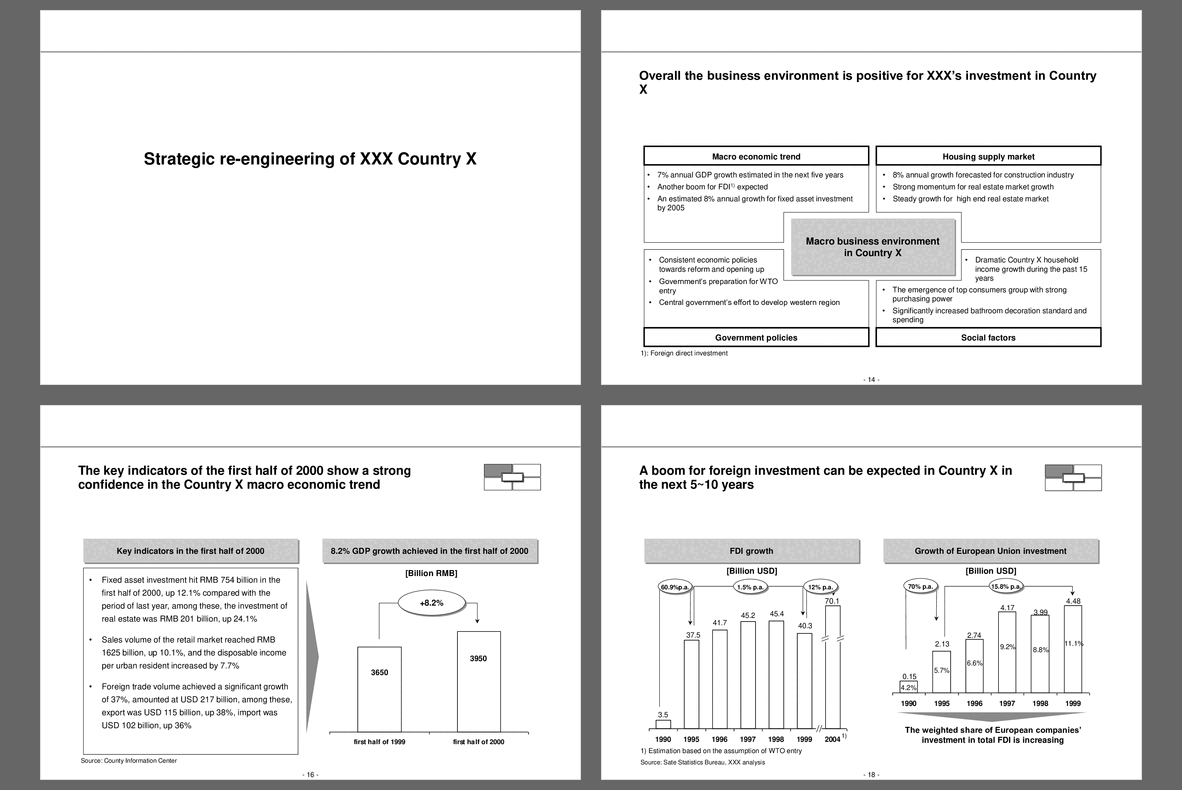







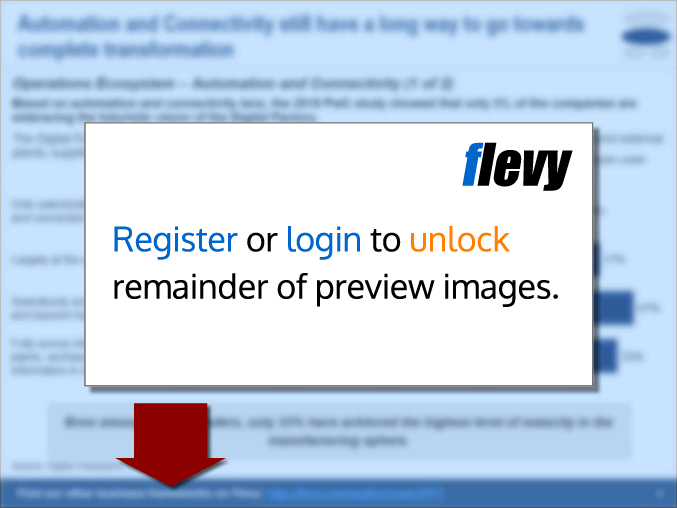








Please login here to save this document to a list.
If you don't have an account, you can register for free here.
Corporate Strategy Design Consulting Report (PowerPoint PPT Slide Deck)
PowerPoint (PPT) 196 Slides
STRATEGIC PLAN EXAMPLE PPT DESCRIPTION
This is a corporate strategy design final report for a European sanitary product manufacturer by a leading consulting firm. Team assessed client's market, competitive environment and potential risk and opportunities, then re-designed its strategy.
This report depicts the following analyses:
1. Macro business environment
2. Market analysis of sanitary system
3. Strategy evaluation
4. Sales & marketing baseline
5. Financial situation
6. Organization and process
7. Restructuring options
The report delves into the macroeconomic environment of Country X, highlighting key indicators such as fixed asset investment and GDP growth, which reflect strong economic trends. Country X's construction industry, being the largest globally, offers immense potential for XXX's piping products. However, the significant price gap between HDPE and Mepla products and local alternatives could pose a barrier to market penetration. The report suggests that long-term commitment and effective marketing strategies are essential to overcome these challenges.
The financial section provides a detailed analysis of GSHA's precarious financial situation, with the company teetering on the brink of bankruptcy. The report outlines the lack of leadership and trust within the organization, leading to high staff turnover and low morale. It also highlights the inefficiencies in the current operational processes, which are production-oriented rather than market-oriented. This misalignment has resulted in a significant increase in operating losses, despite improvements in product mix.
The document also examines the organizational structure and process inefficiencies at GSHA. The frequent changes in organizational structure have not been effectively implemented, leading to overlapping functions and a lack of clear definition. The report emphasizes the need for a more market-oriented approach and better control over the entire process chain to improve efficiency and effectiveness. It also identifies the main problems in the process, including unsuitable process structure, inefficient process control, and the significant differences between document-based processes and real processes.
The restructuring options section explores various scenarios for foreign investment enterprises in Country X, including turnaround, equity structure restructuring, and withdrawal. The report provides a comparative analysis of these alternatives, considering factors such as cost, time, risk, and future integration. It concludes that bankruptcy should be the last resort for XXX, given the high costs, risks, and complexities involved. Instead, the report recommends focusing on equity structure restructuring to gain full control and ensure future success.
Got a question about the product? Email us at support@flevy.com or ask the author directly by using the "Ask the Author a Question" form. If you cannot view the preview above this document description, go here to view the large preview instead.
Source: Best Practices in Strategic Plan Example PowerPoint Slides: Corporate Strategy Design Consulting Report PowerPoint (PPT) Presentation Slide Deck, Documents & Files
STRATEGIC PLAN EXAMPLE PPT SLIDES
Economic Overview of Country X's Western Region

This PPT slide presents a detailed overview of Country X's western region, highlighting its significant natural resources juxtaposed against its lagging economic development as of 1999. The data is organized into 2 main sections: an overview with key indicators and a geographical representation.
The overview section provides critical statistics. The land area is noted as 5.4 million square kilometers, accounting for 57% of the national total. The population stands at 285 million, representing 24% of the country’s total. GDP is reported at USD 133.2 billion, which is only 15% of the national GDP. The GDP per capita is USD 467.4, indicating that the region is performing at 62% of the national average. Income per capita is also low at USD 406, which is 60% of the national figure. These figures collectively illustrate a region rich in resources, but underperforming economically.
The bullet points below the table reinforce this narrative. They indicate that the western region accounts for a mere 4% of total contracted and utilized foreign investment, suggesting a lack of external economic engagement. Despite its wealth in natural resources such as water, gas, and coal, the region seems to be underutilized in terms of economic development.
The geographical map on the right visually emphasizes the western region's boundaries, which consists of ten provinces. This visual aid complements the statistical data, providing a clearer understanding of the area in question. The overall message is clear: while the western region has vast potential, it remains significantly behind in terms of economic progress.
Growth Projections for Sanitary Market Segments

This PPT slide presents a dual focus on the growth prospects of the residential housing and renovation markets, specifically within the context of the sanitary market. It emphasizes that both sectors are poised for significant expansion over the next 5 years, with projected growth rates of 6-8% annually for the overall sanitary market.
On the left, the residential housing growth section outlines key statistics. It states that the real estate market is expected to develop at an annual growth rate of 7-8%. The slide notes an increase in urban residential housing from 450 million square meters in 1998 to 550 million square meters between 2000 and 2005. Additionally, it highlights the acceleration of urbanization, predicting a 2.6% annual increase in the number of cities over the next 15 years. This sets a robust foundation for the sanitary market, as increased housing typically correlates with heightened demand for sanitary products.
The right side of the slide focuses on the renovation market. It indicates that the bathroom decoration market will grow steadily at 5% annually in the same five-year period. A critical point made is the existence of 60-70 million toilet sets in Country X, many of which are outdated or inefficient in water consumption. This presents a clear opportunity for market growth in bathroom renovations, as consumers look to upgrade their facilities.
Overall, the slide effectively communicates the potential for sustained growth in both segments, underlining the interconnectedness of residential development and renovation needs within the sanitary market.
Comparative Analysis of Sales and Marketing Structures

This PPT slide presents a comparative analysis of 2 organizational structures regarding sales and marketing functions within a company, referred to as "XXX." It highlights the contrast between a centralized approach and a divided structure that lacks synergy.
On the left side, the slide outlines the centralized model employed by XXX, which integrates sales and marketing into a cohesive unit. This model is illustrated through a diagram showcasing 3 manufacturing plants located in Foshan, Shanghai, and Beijing, each dedicated to specific product lines: ceramics, bathtubs, and faucets. Below these plants, the XXX Country X sales and marketing company in Shanghai is depicted as a central hub coordinating operations.
Conversely, the right side of the slide illustrates the fragmented approach taken by another entity, also labeled XXX. Here, sales and marketing functions are split into separate components, represented by GSHA, CCS, and GDAI. This division leads to a lack of synergy, as indicated by the bullet points detailing the independent operations of purchasing, production, and customer delivery. The central customer service center (CCSC) is also outlined, emphasizing its roles in pricing, order processing, and after-sales service.
The slide concludes with a mention of around 50 authorized distributors nationwide, indicating a broad distribution network that supports both sales models. Overall, the content suggests that while a centralized approach may foster better integration and efficiency, the divided structure may hinder operational effectiveness and customer engagement. This analysis serves as a critical consideration for stakeholders evaluating the effectiveness of organizational strategies in sales and marketing.
Structured Phases of XXX Sales Process
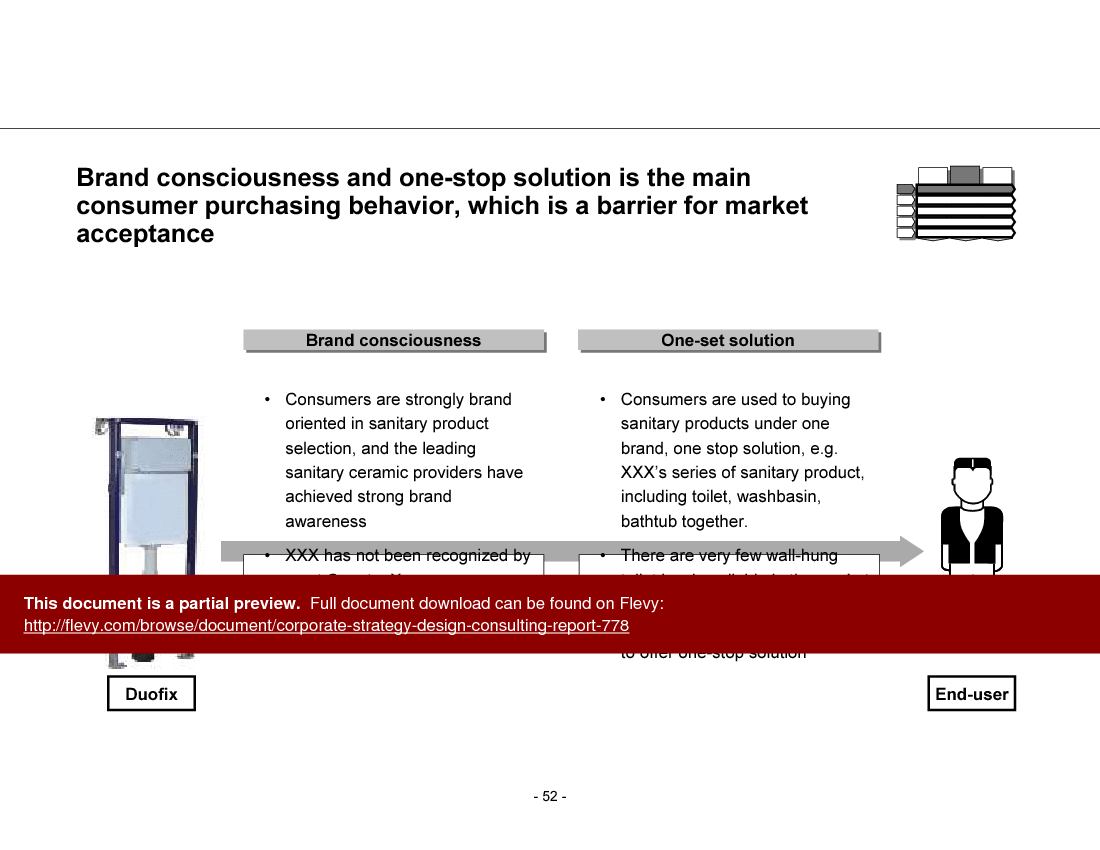
This PPT slide outlines a structured approach to the project sales process for XXX, divided into 4 distinct phases. Each phase is clearly defined, highlighting the steps involved, the processes that need to be followed, and the ownership responsibilities.
In Phase I, titled "Project initiation," the focus is on obtaining governmental approval and setting project conditions. The project owner and developer play a crucial role here, ensuring that all necessary approvals are secured before moving forward. This phase sets the foundation for the subsequent steps.
Phase II, "Project design," involves the design institute running a bidding process for project design. If successful, the design institute will create detailed engineering drawings, which include essential components like the waste drainage system and roof drainage system. This phase emphasizes collaboration between the project owner, developer, and design institute.
The third phase, "Project construction/installation/decoration," is where construction companies are engaged through a bidding process. The winning company is responsible for carrying out the construction and installation work, while a decoration company will handle the finishing touches. This phase illustrates the importance of selecting qualified contractors to ensure project quality.
Finally, Phase IV, "Project completion and ongoing," indicates that once the project is approved, a qualification license will be issued. The focus shifts to ongoing maintenance and after-sales services, which are critical for long-term project success. This phase reinforces the need for continuous engagement with stakeholders, including distributors and project owners.
Overall, the slide effectively communicates a comprehensive process that emphasizes clarity in roles and responsibilities at each stage, ensuring a streamlined approach to project sales.
Liquidity Crisis: Current Liabilities vs. Assets Overview
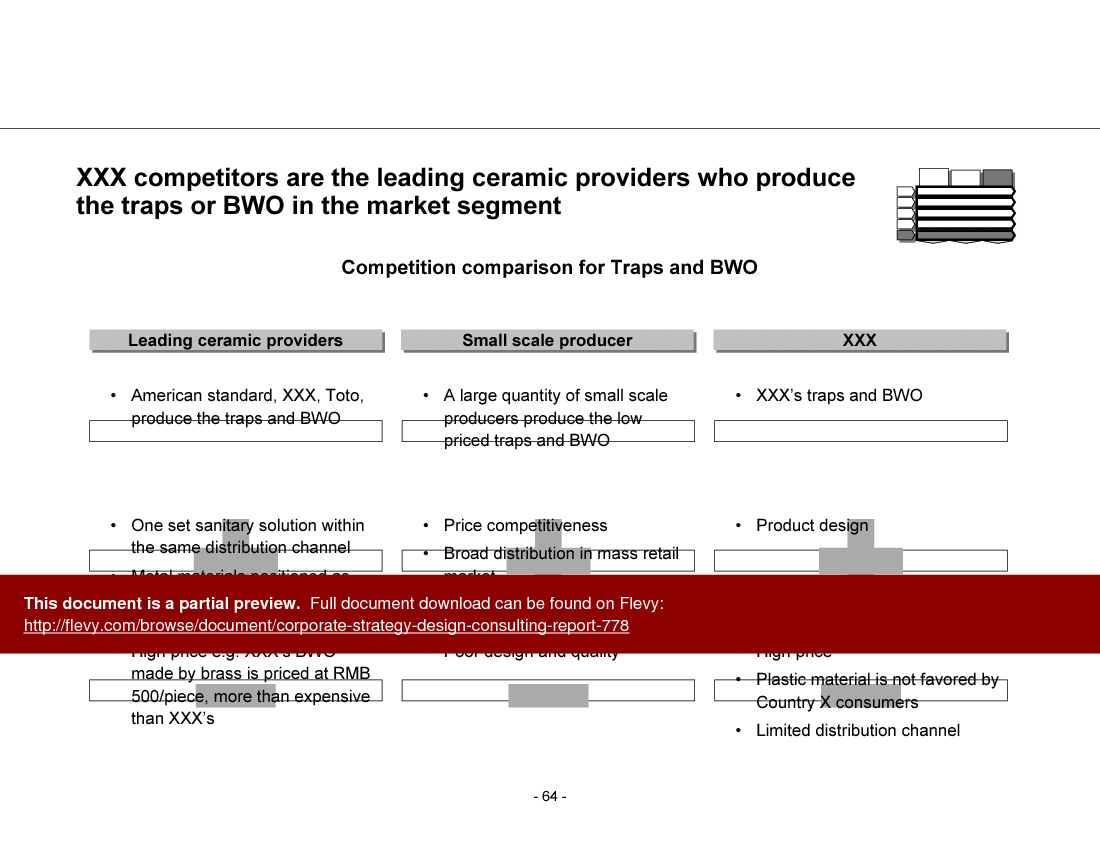
This PPT slide presents a critical overview of a company's liquidity situation, highlighting a concerning trend where current liabilities are outpacing current assets. The visible data indicates a significant increase in liabilities, with a staggering growth rate of 522% from the previous year. In contrast, current assets have only seen a modest increase of 37%. This disparity raises alarms about the company's financial health and its ability to meet short-term obligations.
The bar graph illustrates the development of liabilities and assets over a three-year period, with figures in RMB '000. The current ratio, which is a measure of liquidity, has sharply declined from 2.82 in 1998 to 0.62 in 2000, suggesting that the company is increasingly reliant on external cash injections to cover operational expenses rather than investing in asset growth. This trend is unsustainable and could lead to severe financial distress if not addressed promptly.
The slide also notes that cash from the parent company is being utilized primarily for running expenses, rather than for strengthening the asset base. This reliance on external funding could indicate deeper operational inefficiencies or market challenges that need to be tackled. Stakeholders should be aware that the current trajectory may jeopardize the company’s long-term viability if corrective measures are not implemented swiftly. The data presented serves as a wake-up call for management to reassess their financial strategies and operational practices to restore balance and ensure sustainability.
Investment Climate Assessment for Country X

This PPT slide presents an analysis of the business environment in Country X, emphasizing its favorable conditions for investment by XXX. It is divided into 2 primary sections: macroeconomic trends and the housing supply market.
In the macroeconomic trend section, the slide highlights a projected 7% annual GDP growth over the next 5 years, indicating a robust economic outlook. There is also mention of an anticipated boom in foreign direct investment (FDI), suggesting an influx of capital and resources into the country. Furthermore, an 8% annual growth in fixed asset investment is expected by 2005, which reflects confidence in the infrastructure and development sectors. The slide notes consistent economic policies aimed at reform and opening up the market, alongside the government's preparations for World Trade Organization (WTO) entry. These factors contribute to a stable and inviting investment climate.
The housing supply market section outlines an 8% annual growth forecast for the construction industry, indicating a strong demand for housing and related services. The momentum in the real estate market is further emphasized, with steady growth noted in the high-end real estate segment. The slide also points to a significant increase in household income over the past 15 years, which has led to the emergence of a top consumer group with substantial purchasing power. This demographic shift is crucial for businesses targeting the luxury market. Additionally, there is a noted rise in spending on bathroom decoration, which could signal opportunities for companies in the home improvement and sanitary sectors.
Overall, the slide effectively conveys a positive investment climate in Country X, driven by strong economic indicators and a burgeoning housing market.
Urban Income and Consumption Growth in Country X

This PPT slide presents a comparative analysis of the annual per capita disposable income and consumption of urban residents in Country X over a 15-year period. It highlights significant growth trends in both income and consumption metrics, indicating a robust economic development trajectory.
On the left side, the annual per capita disposable income is illustrated. The figures start from 739.1 RMB in 1999, showing a steady increase to 5854.0 RMB. The growth rates are prominently displayed, with a notable 22% annual increase at one point. This suggests that urban residents have experienced substantial improvements in their financial capacity, which likely correlates with broader economic reforms or growth initiatives in Country X.
The right side of the slide mirrors this analysis with annual per capita consumption data. Starting from 802 RMB in 1999, the consumption has escalated to 6750 RMB. Similar growth rates are noted, with a consistent 22% annual increase at certain intervals. This indicates that as disposable income rises, consumption patterns are also evolving, reflecting a shift in consumer behavior and possibly an increase in demand for various goods and services.
The overall message is clear: the urban population in Country X has seen a dramatic increase in both income and consumption over the last 15 years. This information is crucial for stakeholders considering market entry or investment opportunities, as it underscores a growing consumer base with enhanced purchasing power. Understanding these trends can guide strategic decisions in product offerings and market positioning.
Market Demand Analysis for Sanitary Ceramic Fittings
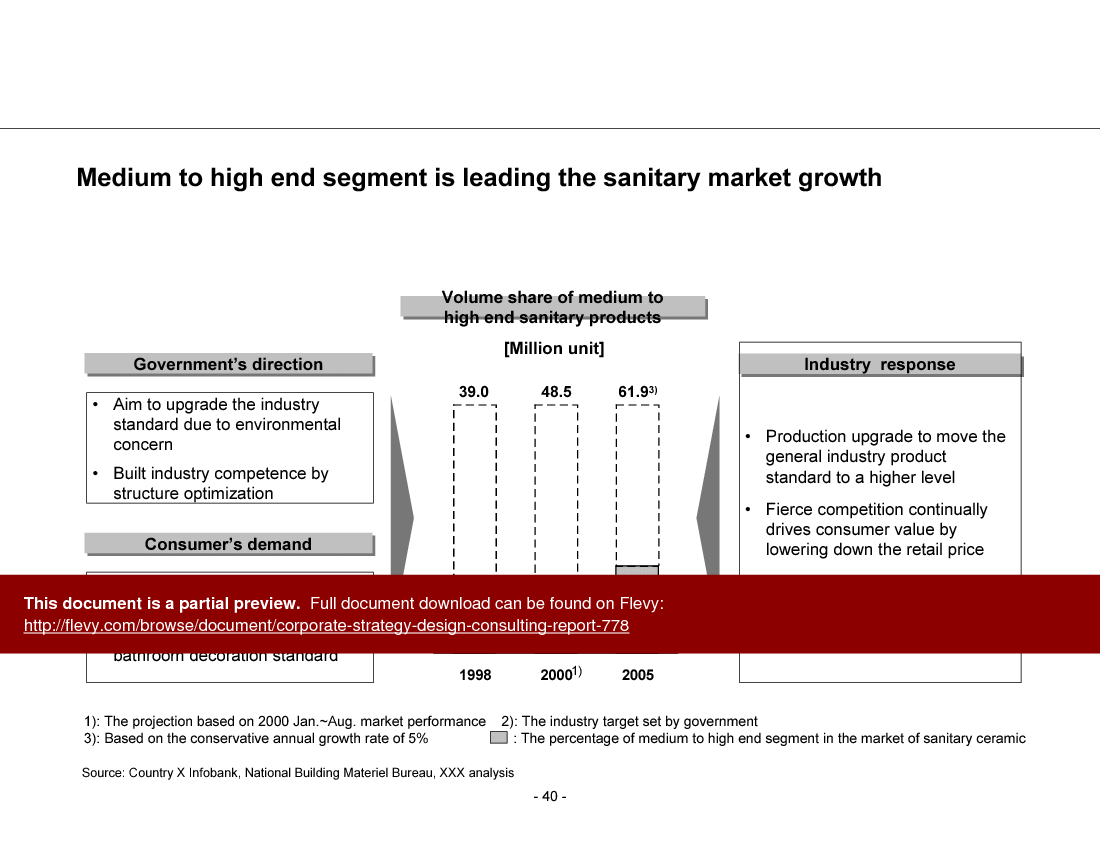
This PPT slide presents an overview of the demand for medium to high-end tank fittings within the sanitary ceramic manufacturing sector, specifically focusing on data from 1999. It highlights that approximately 20 leading manufacturers in this industry collectively require around 2 million sets of these fittings annually.
In the table, several key players are listed alongside their estimated annual demand figures. American Standard leads with a demand of 270,000 sets, followed closely by TOTO at 230,000. Other notable manufacturers include XXX, HCG, Swell, and Altima, with demands ranging from 80,000 to 160,000 sets. This data indicates a significant market presence among these top players, suggesting a concentrated demand that could impact supply chain strategies and pricing.
Additionally, the slide notes other target OEM customers for XXX’s tank fittings, including companies like INAX, Imperial, Dynasty, Roca, and others. This information implies potential avenues for collaboration or competition within the market.
The overall structure of the slide effectively conveys critical market insights, making it a valuable resource for stakeholders looking to understand demand dynamics in the sanitary ceramic sector. The clear presentation of data allows for quick analysis, which is essential for strategic decision-making. Understanding these demand figures could guide companies in aligning their production capabilities and marketing strategies to better meet market needs.
Analysis of Rising Short-Term Liabilities
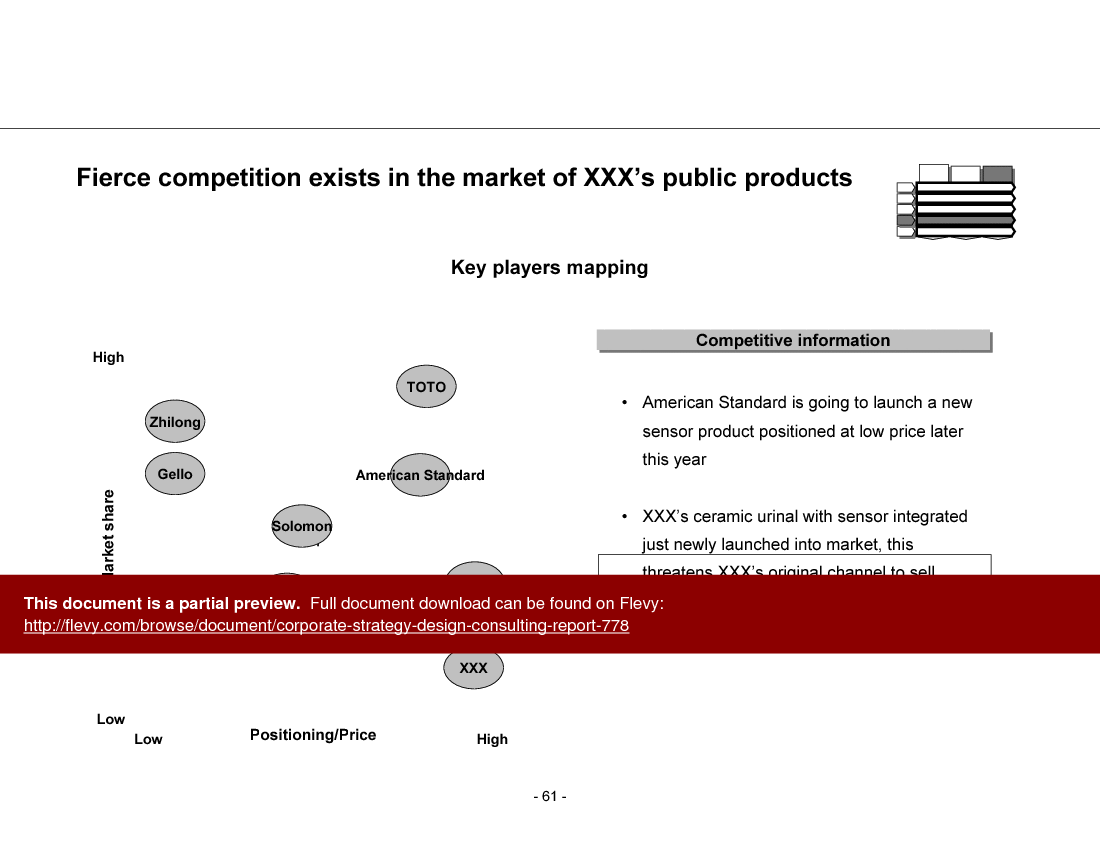
This PPT slide presents a stark overview of the company's financial liabilities, emphasizing that all liabilities are short-term and have increased significantly, projected to quadruple. By July 2000, these liabilities are expected to constitute 75% of total assets, which raises critical concerns regarding liquidity and financial stability.
The graphical representation illustrates the development of liabilities as a percentage of total assets over time. Initially, liabilities accounted for 13.4% of total assets, which then escalated to 46.4%. This marks a staggering increase of 522%, indicating a rapid deterioration in the company's financial health. The final projection shows that liabilities will reach 75% of total assets, amounting to 25,352 RMB '000.
This data suggests an urgent need for strategic financial management. The rapid rise in short-term liabilities could hinder the company's ability to meet its obligations, potentially leading to cash flow issues. Stakeholders should be aware of these trends, as they could impact investment decisions and overall company valuation.
The slide serves as a crucial warning sign for executives and investors alike. It underscores the importance of addressing the underlying causes of this liability growth and developing strategies to mitigate risks associated with high short-term debt. Without intervention, the company may face significant challenges in maintaining operational stability and achieving long-term growth.
Strategic Initiatives for Sustainable Economic Growth

This PPT slide outlines the strategic initiatives of Country X's government aimed at fostering sustainable economic growth. It presents a structured approach through 4 key areas: Market Reform, Open-up, Domestic Market Demand Driven, and Western Region Development.
Market Reform emphasizes the importance of State-Owned Enterprise (SOE) reform. The government recognizes that prioritizing SOE reform is essential for long-term economic viability. However, this may involve short-term challenges, including significant workforce reductions. This highlights the delicate balance between necessary reforms and the socio-economic impacts they may entail.
The Open-up section focuses on adopting a market-oriented development strategy. The government aims to further liberalize the market, preparing for World Trade Organization (WTO) entry. This move is expected to attract foreign investment and enhance export capabilities, indicating a commitment to integrating into the global economy.
Domestic Market Demand Driven outlines the government's role in stimulating local economic activity. It stresses the need for continued investment in infrastructure, which is crucial for supporting growth. Additionally, it suggests prioritizing real estate development through favorable policies, thereby creating a more robust domestic market.
Western Region Development addresses regional disparities in economic growth. The government seeks to bridge the gap between coastal and western regions, aiming to create additional domestic market demand through targeted initiatives. This reflects an understanding of the need for balanced regional development as a component of overall economic strategy.
Overall, the slide presents a comprehensive framework for economic growth, balancing reform, market opening, domestic demand stimulation, and regional development. Each element is interconnected, suggesting that successful implementation will require coordinated efforts across multiple fronts.
Consumer Expectations Shaping Sanitary Product Design
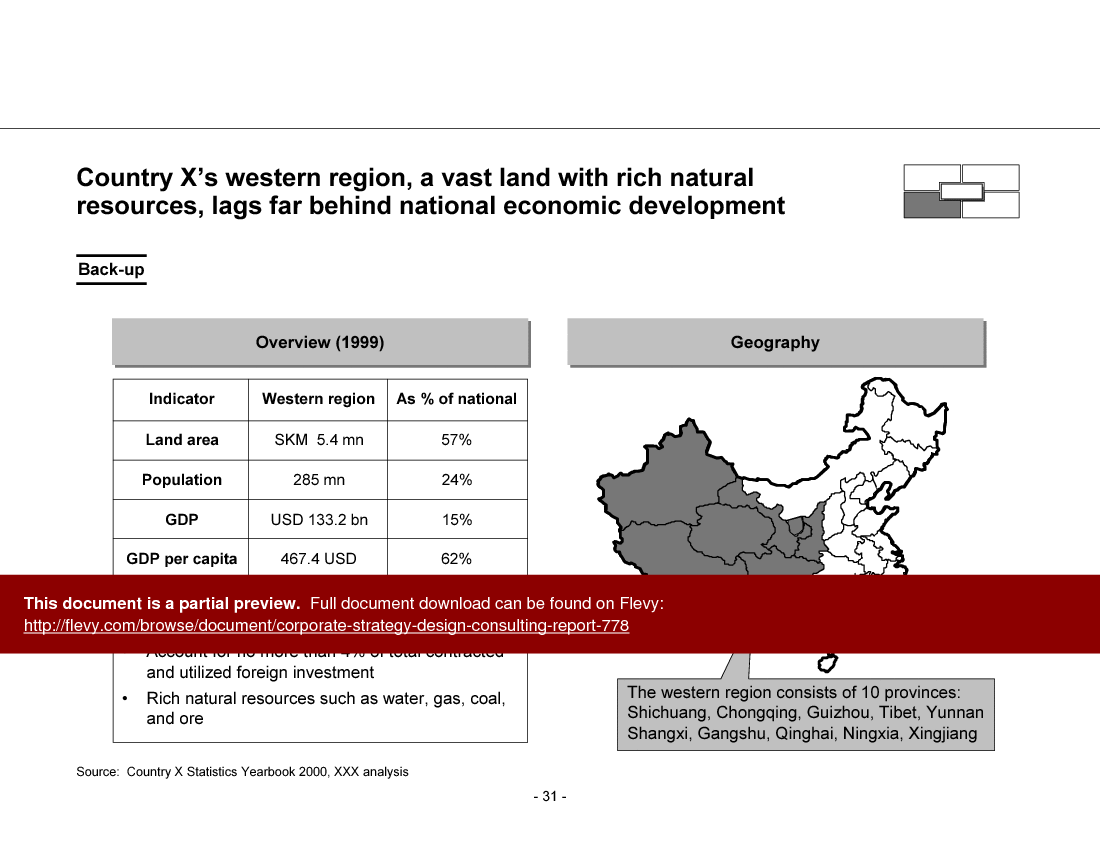
This PPT slide outlines the evolving demands of consumers in Country X regarding sanitary products. It presents a central focus on "Consumer demands on sanitary products," surrounded by 6 key factors that influence these demands.
Functionality is highlighted as a primary concern, emphasizing the need for effective flushing, odor-free operation, and low noise levels. These attributes are critical for consumer satisfaction and reflect a shift towards higher performance standards in sanitary products.
Brand image is another significant factor, where popularity in media and the emotional benefits associated with a brand play a vital role. Consumers are increasingly influenced by how brands are perceived, which can impact their purchasing decisions.
The concept of environmental friendliness is also crucial. Government regulations now mandate that toilets must have a maximum flush capacity of 9 liters. However, there is a gap in consumer awareness regarding water-saving technologies. Consumers expect products to be leak-free and to incorporate dual flush mechanisms, indicating a growing consciousness about sustainability.
After-sales service is mentioned, with a focus on warranty and maintenance, suggesting that consumers value long-term support and reliability from manufacturers.
Product value, defined as the ratio of quality to price, is essential for consumers who are looking for cost-effective solutions without compromising on quality.
Lastly, product design is noted for its aesthetic appeal and innovative concepts, indicating that consumers are not just looking for functionality, but also for products that enhance their living spaces.
This comprehensive overview suggests that manufacturers must adapt to these evolving consumer expectations to remain competitive in the market.
Comparative Analysis of Roof Drainage Systems
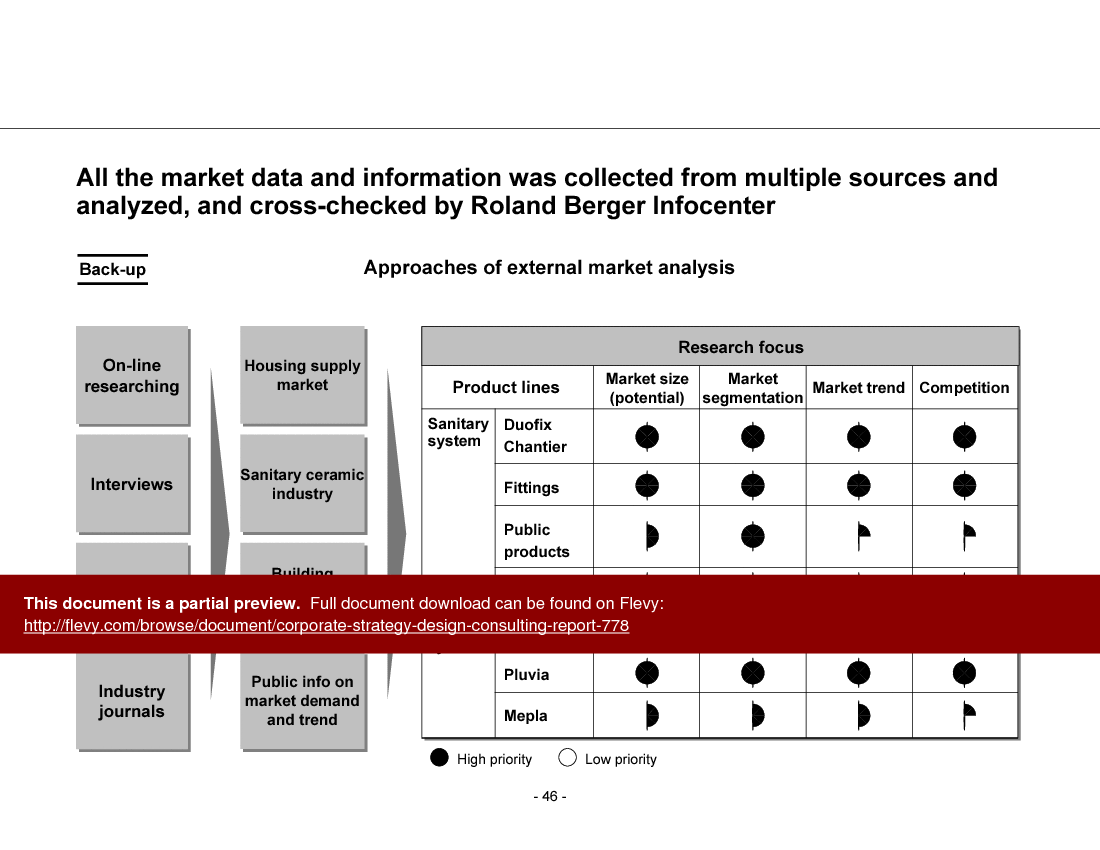
This PPT slide presents a comparative analysis of 2 roof drainage systems: the traditional gravity-driven system and the Pluvia siphonic roof drainage system, specifically in the context of Country X.
On the left side, the gravity-driven system is outlined, highlighting its reliance on gravity for drainage. It notes that this method is predominantly used by architects in Country X. However, it points out significant drawbacks, including low efficiency in water drainage, which can lead to potential issues during heavy rainfall. The complexity of designing large-scale roofs with this system is also mentioned, along with an increased workload for construction teams, indicating a less streamlined approach.
Conversely, the right side of the slide details the advantages of the Pluvia system. It emphasizes superior rainwater drainage functionality, suggesting that this system is more effective at managing water flow. The slide notes that Pluvia employs horizontal rainwater collection piping, which eliminates the need for roof declination, simplifying installation. This aspect can reduce the number of pipes required, leading to less material usage and a more efficient installation process. Furthermore, it highlights a reduced workload for pipe installation, which can translate to lower labor costs and faster project timelines. The slide concludes by asserting that the Pluvia system offers significant advantages for large-scale buildings, positioning it as a more favorable option compared to traditional methods.
This analysis provides valuable insights for decision-makers considering roof drainage solutions, particularly in complex architectural projects.
Challenges of Differentiation Strategy in Country X

This PPT slide outlines the challenges of implementing a differentiation strategy in Country X for a European entity, identified as XXX Europe. The central theme revolves around the pillars of a high-priced differentiation strategy, which are premium technology and innovation, premium quality, premium customer services, and premium brand and reputation. Each pillar is crucial for establishing a strong market presence and justifying higher pricing.
On the right side, the slide presents a SWOT-like analysis of the situation in Country X. It highlights positive aspects, such as advanced technology and reliable quality, which suggest that there is a foundation upon which to build. However, it also points out significant drawbacks. Customer service is noted as unsatisfactory, which could deter potential buyers and undermine brand loyalty. Additionally, low brand awareness poses a risk, as it limits the market's recognition of the premium offerings.
The juxtaposition of strengths and weaknesses indicates that while there are favorable conditions for technology and quality, the overall strategy may falter without addressing customer service and brand visibility. This analysis suggests that a tailored approach is necessary for Country X, rather than a direct application of the differentiation strategy used in Europe. Potential customers should consider these insights when evaluating the viability of the proposed strategy and the necessary adjustments to meet local market conditions.
Projected Surge in Foreign Investment in Country X

This PPT slide presents a compelling overview of anticipated foreign direct investment (FDI) growth in Country X over the next 5 to ten years, alongside the growth of European Union investment in the same period. The left section details FDI growth, with figures indicating a significant increase from $3.5 billion to $70.1 billion, showcasing a remarkable annual growth rate of 60.9% in the initial year. Subsequent years show a more moderate growth rate of 1.5% and 12%, suggesting a stabilization after an initial surge.
The right section illustrates the growth of European Union investment, which also demonstrates a positive trend. Starting at $0.15 billion in 1990, it escalates to $4.48 billion by 1999, reflecting an annual growth rate of 70% in the early years, tapering to 15.8% in later years. This indicates a robust interest from European investors, which could be attributed to favorable economic conditions or policy reforms in Country X.
Both sections use bar graphs to visually represent the data, making it easier for stakeholders to grasp the trends at a glance. The stark contrast in growth rates between the 2 segments highlights the potential for Country X to attract substantial foreign investment, particularly from European sources. This information is crucial for potential investors or stakeholders considering entry into the market, as it underscores the evolving investment climate and the opportunities that may arise in the coming years. The data suggests that while initial growth may be explosive, the long-term outlook remains positive, making it a strategic consideration for investment planning.
Projected Major Construction Projects in Country X

This PPT slide presents a comprehensive overview of projected construction projects in Country X, emphasizing significant developments anticipated over the next 5 years. It begins with a striking estimate that over 100 projects, each exceeding 10,000 square meters in roof area, are expected annually. This sets a substantial context for potential investors and stakeholders.
The left section categorizes projects by building type, highlighting 3 key areas: airports, stadiums, and large-scale plants. Notably, there is an expectation for more than 25 airports to be built or renovated, indicating a robust investment in transportation infrastructure. The construction of over 50 stadiums also signals a commitment to enhancing sports facilities, likely aimed at boosting tourism and local economies. Furthermore, the mention of WTO entry suggests an increase in foreign direct investment, which could lead to the establishment of large-scale manufacturing plants, reflecting a broader economic strategy.
On the right side, the pie chart breaks down project estimations by region, providing a regional perspective on where these developments will occur. The North region is projected to have 35 projects, while the South region leads with 40. The Central region, though smaller, still accounts for 25 projects. This regional distribution is crucial for understanding where to focus resources and strategic planning.
Overall, the slide serves as a valuable resource for decision-makers considering investment opportunities in Country X's construction sector. The detailed projections and regional insights can guide strategic initiatives and resource allocation effectively.
Chantier's Market Positioning in Sanitary Ware
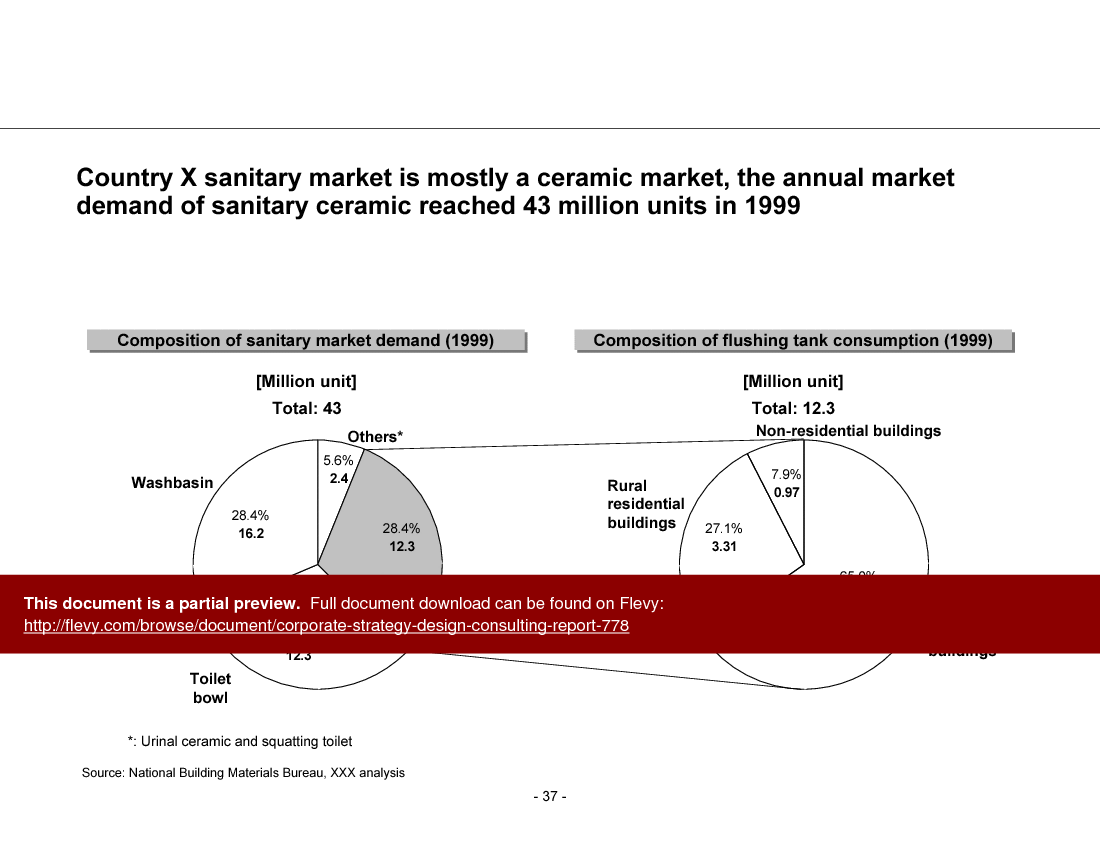
This PPT slide presents a competitive analysis of Chantier, specifically in the context of the exposed flushing tank market. It positions Chantier against several leading ceramic providers, including American Standard, TOTO, and Caroma, within a two-dimensional matrix that measures market share against competitiveness. The positioning of these brands suggests that Chantier operates in a space with varying levels of market presence and competitive strength.
Chantier is located in a lower market share quadrant, indicating that it holds a smaller portion of the market compared to its competitors. The text emphasizes that Chantier's competitiveness is notably distant from the leaders in the sanitary market, implying challenges in gaining traction against established brands. This distance suggests that while Chantier is present in the market, it may struggle to compete effectively on factors that drive market leadership, such as brand recognition, product innovation, or distribution networks.
Furthermore, the slide points out that Chantier does not compete with low-end plastic tank manufacturers. This distinction highlights a strategic choice to position itself away from the lower segment of the market, potentially focusing on higher-quality ceramic products. This could indicate a deliberate strategy to appeal to a more discerning customer base that values durability and aesthetics over cost.
Overall, the analysis provides insight into Chantier's current market positioning and competitive dynamics, which could be critical for stakeholders considering investment or strategic partnerships in the sanitary ware sector. Understanding these dynamics can inform decisions about product development, marketing strategies, and potential areas for growth.
Market Segmentation Analysis for XXX's Sanitary Products
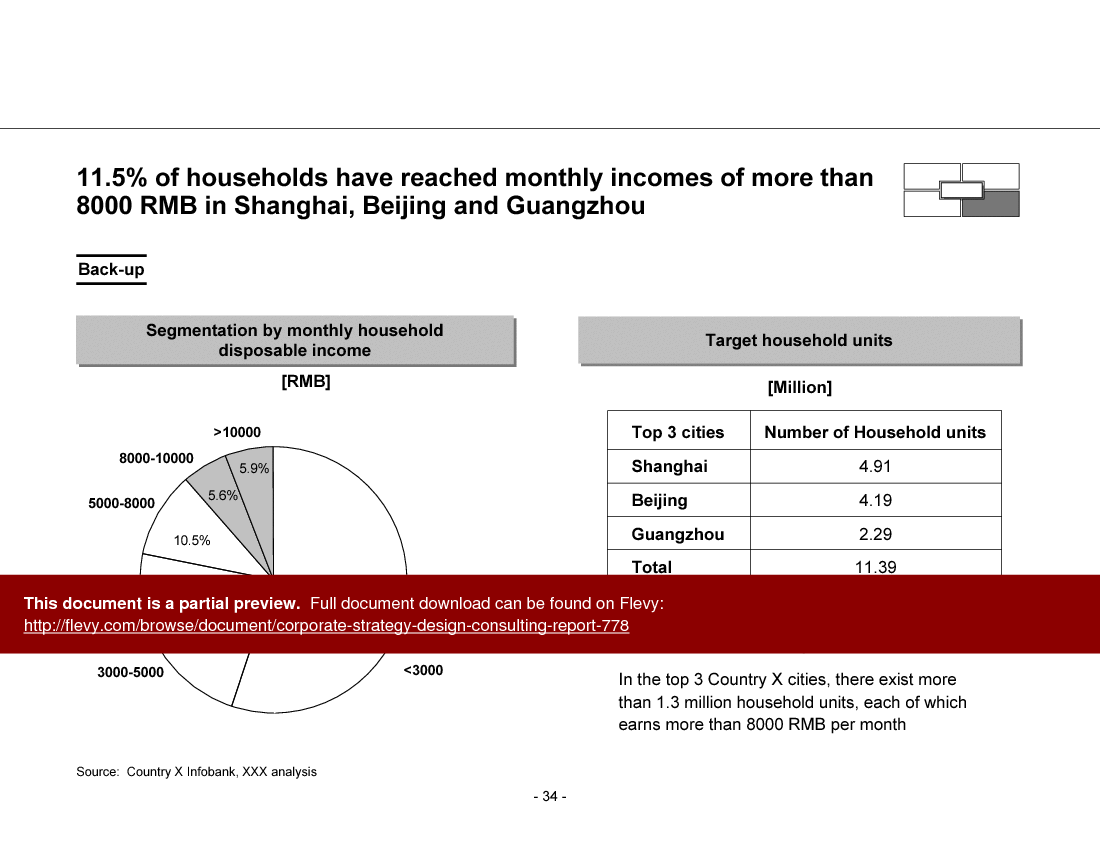
This PPT slide presents a detailed market segmentation analysis for XXX’s sanitary products, specifically focusing on their positioning within the high-end, medium, and low-end segments. It outlines the market size in millions of units for various product categories, such as concealed cisterns, exposed plastic tanks, tank fittings, urinal flushing systems, public faucets, and traps.
Each product category is accompanied by percentage figures that indicate the distribution of market share across the 3 segments. For instance, concealed cisterns and exposed plastic tanks show a consistent 10% share in the high-end segment, while the low-end segment captures a substantial 85%. This pattern suggests a significant opportunity for XXX in the low-end market, though the company is currently limited to medium and high-end sales.
The slide also highlights the accessible market for XXX, which is notably constrained. For example, the accessible market for concealed cisterns is only 5% of the high-end segment. This indicates that while there is a robust demand in the low-end segment, XXX's products are not positioned to capitalize on it effectively. The competitiveness column further emphasizes the varying levels of market entry difficulty across product categories, with some being categorized as "medium to high end" and others as "high end."
Overall, this slide provides a clear snapshot of XXX’s market positioning and potential growth areas. It reveals the challenges the company faces in expanding its reach into lower segments while underscoring the importance of strategic focus on high-end offerings. Understanding these dynamics is crucial for any stakeholder considering engagement with XXX.
Key Economic Indicators for Country X in 2000

This PPT slide presents key economic indicators for the first half of 2000 in Country X, highlighting a robust macroeconomic environment. It outlines several critical metrics that reflect growth and investment trends. Fixed asset investment reached RMB 754 billion, marking a 12.1% increase compared to the previous year. Notably, real estate investment surged by 24.1%, indicating a strong confidence in the sector.
Retail market dynamics also show positive movement, with sales volume hitting RMB 1625 billion, a 10.1% rise. The increase in disposable income per urban resident by 7.7% suggests improved consumer spending capacity, which is vital for sustained economic growth.
Foreign trade figures are particularly striking, with a 37% growth in trade volume, totaling USD 217 billion. Exports rose by 38%, while imports increased by 36%, reflecting a healthy trade balance and international engagement. The slide also emphasizes an 8.2% GDP growth for the same period, further underscoring the economic vitality of Country X.
This data paints a picture of a thriving economy, characterized by significant investments, rising consumer confidence, and expanding trade. For potential customers, these indicators suggest a favorable environment for business opportunities and investments in Country X. Understanding these metrics can help in making informed decisions regarding market entry or expansion strategies.
Assessing Core Competence Transfer: Europe vs. Country X

This PPT slide presents a comparative analysis of core competencies between XXX Europe and XXX Country X. It highlights that the competencies from Europe have not been effectively transferred to Country X, indicating a gap that could impact performance and market positioning.
On the left side, the core competencies of XXX Europe are listed, starting with advanced technology, which suggests a strong foundation in innovation. The next point, superior quality, reinforces the brand’s commitment to excellence. Good pre and after-sales services are also noted, indicating a customer-centric approach that enhances client satisfaction and loyalty. Good technical support follows, which is crucial for maintaining operational efficiency and customer trust. Finally, brand reputation is mentioned, reflecting the established credibility and recognition in the market.
Conversely, the right side outlines the competencies in Country X. High technology is acknowledged,, but it appears to lack the depth found in Europe. High quality is also noted, yet it seems to be at a different level compared to the European standard. The mention of underdeveloped pre and after-sales services indicates a significant area for improvement. Poor technical support is a critical concern, as it can lead to customer dissatisfaction and erosion of trust. Lastly, the brand presence in Country X is described as not established, which poses a challenge for market penetration and growth.
This analysis suggests that while there are some overlapping competencies, the transfer of knowledge and practices has not been successful. Addressing these gaps will be essential for XXX to enhance its operations and reputation in Country X.
ABOUT THE AUTHOR
Ask the Author a Question
You must be logged in to contact the author.
|
|
"The wide selection of frameworks is very useful to me as an independent consultant. In fact, it rivals what I had at my disposal at Big 4 Consulting firms in terms of efficacy and organization."
– Julia T., Consulting Firm Owner (Former Manager at Deloitte and Capgemini)
|
|
|
"As a young consulting firm, requests for input from clients vary and it's sometimes impossible to provide expert solutions across a broad spectrum of requirements. That was before I discovered Flevy.com.
Through subscription to this invaluable site of a plethora of topics that are key and crucial to consulting, I ... [read more] have been able to exceed expectations and deliver quality advice and solutions to my clients. The quality and expertise of the authors are exemplary and gives me great confidence to use as part of my service offerings.
"
I highly recommend this company for any consultant wanting to apply international best practice standards in their service offerings. – Nishi Singh, Strategist and MD at NSP Consultants
|
|
|
"As an Independent Management Consultant, I find Flevy to add great value as a source of best practices, templates and information on new trends. Flevy has matured and the quality and quantity of the library is excellent. Lastly the price charged is reasonable, creating a win-win value for ... [read more] the customer, Flevy and the various authors. This is truly a service that benefits the consulting industry and associated clients. Thanks for providing this service. "
– Jim Schoen, Principal at FRC Group
|
|
|
"As a consultant requiring up to date and professional material that will be of value and use to my clients, I find Flevy a very reliable resource.
The variety and quality of material available through Flevy offers a very useful and commanding source for information. Using Flevy saves me time, enhances my expertise and ends up being a good decision." – Dennis Gershowitz, Principal at DG Associates
|
|
|
"Last Sunday morning, I was diligently working on an important presentation for a client and found myself in need of additional content and suitable templates for various types of graphics. Flevy.com proved to be a treasure trove for both content and design at a reasonable price, considering the time I ... [read more] saved. I encountered a download issue during the ordering process. However, a quick email to Flevy's support team, even on a Sunday (!!!), resulted in assistance within less than an hour, allowing me to download the content I needed. Fantastic job, Flevy! I give 5 stars for both content/price and customer service. Thank you! "
– M. E., Chief Commercial Officer, International Logistics Service Provider
|
|
|
"Flevy is our 'go to' resource for management material, at an affordable cost. The Flevy library is comprehensive and the content deep, and typically provides a great foundation for us to further develop and tailor our own service offer."
– Chris McCann, Founder at Resilient.World
|
|
|
"As a small business owner, the resource material available from FlevyPro has proven to be invaluable. The ability to search for material on demand based our project events and client requirements was great for me and proved very beneficial to my clients. Importantly, being able to easily edit and tailor ... [read more] the material for specific purposes helped us to make presentations, knowledge sharing, and toolkit development, which formed part of the overall program collateral. While FlevyPro contains resource material that any consultancy, project or delivery firm must have, it is an essential part of a small firm or independent consultant's toolbox. "
– Michael Duff, Managing Director at Change Strategy (UK)
|
|
|
"I have used FlevyPro for several business applications. It is a great complement to working with expensive consultants. The quality and effectiveness of the tools are of the highest standards."
– Moritz Bernhoerster, Global Sourcing Director at Fortune 500
|
